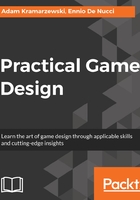
Key feature set
This is a list of the features that make your game a great experience for your players. There's no need to include all the system you will be designing, but it is expected that a game concept includes all the main ones. This means that a healthy development cycle starts with a fundamental feature set that remains largely unchanged (unless things don't work out as expected and you find yourself in dire need of a big design pivot).
Some common key features are game modes, multiplayer guild systems, battle systems, playable characters, progression systems, and technical features (such as advanced AI or particular graphics). The list is as long as a designer's imagination can go, so make sure to include only the ones really relevant to your game.
To look at some practical examples, the App Store gives some very good insights. Most App Store descriptions contain a list of the game's key features. Hearthstone, for example, markets itself with the following messages:
As you can see, Blizzard did an excellent job of mixing technical and gameplay features, describing them with taglines that make players excited about their trading card game. These messages were obviously written by the marketing team for the finished product, but they are a perfect example of clearly and efficiently communicating the key feature set to the target audience.